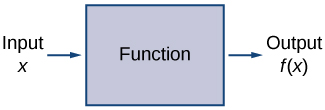| << Chapter < Page | Chapter >> Page > |
In this section, we provide a formal definition of a function and examine several ways in which functions are represented—namely, through tables, formulas, and graphs. We study formal notation and terms related to functions. We also define composition of functions and symmetry properties. Most of this material will be a review for you, but it serves as a handy reference to remind you of some of the algebraic techniques useful for working with functions.
Given two sets and a set with elements that are ordered pairs where is an element of and is an element of is a relation from to A relation from to defines a relationship between those two sets. A function is a special type of relation in which each element of the first set is related to exactly one element of the second set. The element of the first set is called the input ; the element of the second set is called the output . Functions are used all the time in mathematics to describe relationships between two sets. For any function, when we know the input, the output is determined, so we say that the output is a function of the input. For example, the area of a square is determined by its side length, so we say that the area (the output) is a function of its side length (the input). The velocity of a ball thrown in the air can be described as a function of the amount of time the ball is in the air. The cost of mailing a package is a function of the weight of the package. Since functions have so many uses, it is important to have precise definitions and terminology to study them.
A function consists of a set of inputs, a set of outputs, and a rule for assigning each input to exactly one output. The set of inputs is called the domain of the function. The set of outputs is called the range of the function.
For example, consider the function where the domain is the set of all real numbers and the rule is to square the input. Then, the input is assigned to the output Since every nonnegative real number has a real-value square root, every nonnegative number is an element of the range of this function. Since there is no real number with a square that is negative, the negative real numbers are not elements of the range. We conclude that the range is the set of nonnegative real numbers.
For a general function with domain we often use to denote the input and to denote the output associated with When doing so, we refer to as the independent variable and as the dependent variable , because it depends on Using function notation, we write and we read this equation as equals of For the squaring function described earlier, we write
The concept of a function can be visualized using [link] , [link] , and [link] .


Notification Switch
Would you like to follow the 'Calculus volume 1' conversation and receive update notifications?